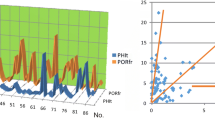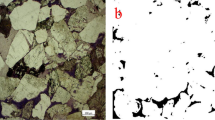Abstract
Modern methods of lithological research allow obtaining results in digital form. This increases the objectivity, accuracy, reliability of data on rocks and makes possible their further computer processing and modeling. The article studies the issue of analyzing the composition and properties of rocks using digital photographs of the core sample. Existing techniques shall be considered. A scheme for the automated assessment of porosity and fracture parameters based on photographs of petrographic thin sections shall be proposed: 1) semi-automatic selection of voids by color; 2) automatic selection of cracks based on geometric features; 3) estimation of parameters of absolute porosity, total length and average width of cracks. To highlight voids, color filtering was applied with interactive input of the values of the classification attributes. Allocation of cracks from the general mass of voids was carried out according to the characteristics of the shape and area. The value of the absolute porosity was estimated as the ratio of the area of the selected voids to the total area of the photography. To determine the average width and total length of the cracks, the inscribed rectangle approximation was used. The scheme is implemented using algorithms of the OpenCV library, integrated into a custom software application. Convergence of the results of using the application with the results of a non-automated expert assessment for the parameter of porosity 80%, fracturing 70%. Estimation errors refer to cases of low color contrast of voids and mineral skeleton and segmentation of fracture lines in the original photographs. When using the application, a significant increase in speed and a decrease in the labor intensity of a specialist’s work was obtained. This allows us to recommend the developed application for express analysis of photographs of core thin sections.
Access this chapter
Tax calculation will be finalised at checkout
Purchases are for personal use only
Similar content being viewed by others
References
Poshibaev VV, Konovaltseva ES, Omelchenko OV, Kuznetsov AS (2012) Lithological studies of core using modern hardware and software systems. In: Baltic School-Seminar: Petrophysical Modeling of Sedimentary Rocks Petromodel-2013, pp 1–9
Prince CM, Chitale J (2008) Core image analysis: reliable pay estimation in thin-bedded reservoir units. In: Society of Core Analysts Annual Meeting, pp 1–6
Baraboshkin EE, Ismailova LS et al (2019) Deep convolutions for in-depth automated rock typing. Computer Geosci 135. https://doi.org/10.1016/j.cageo.2019.104330
Akinshin AV, Akmanaev AR, Efimov VA (2013) Determination of the proportion of clay layers and inclusions from photographs of the core sample. Oil Ind 10:88–90
Khasanov II (2013) Method of quantitative evaluation of chromaticity of core material and its practical application. In: Materials of the Baltic School Seminar Petrophysical Modeling of Sedimentary Rocks, Petromodel 2013
Postnikov AV, Khasanov II (2015) Computer modeling of structural and texture features of rocks. In: Proceedings of the Baltic School-Seminar etrophysical Modeling of Sedimentary Rocks. Petromodel 2015. St. Petersburg
Khasanov II, Ponomarev IA, Postnikov AV, Osintseva NA (2016) Methods for the quantitative assessment of the reservoir parameters of rock reservoirs using digital processing of core photos. In: Conference: Geomodel 2016–18th Science and Applied Research Conference on Oil and Gas Geological Exploration and Development, September 2016. https://doi.org/10.3997/2214-4609.201602277
Ellington WEJ, Moore JC, Smith MA, Dubinsky GL (2013) Products and methods for identifying rock samples. Pat. US 2013/0156270 A1
Patel AK, Chatterjee S, Gorai AK (2017) Development of online machine vision system using support vector regression (SVR) algorithm for grade prediction of iron ores. In: 2017 Fifteenth IAPR International Conference on Machine Vision Applications (MVA), pp 149–152. IEEE
Baraboshkin EE, Ismailova LS, Baraboshkin EYu, Ivchenko A (2018) Core photo lithological interpretation based on computer analyses. In: Proceedings of the 2018 IEEE Northwest Russia Conference on Mathematical Methods in Engineering and Technology (ММET NW 2018), pp. 426–428
Baraboshkin E, Ismailova L, Orlov D, Koroteev D (2019) Machine vision methods in the application for core image segmentation. In: European Association of Geoscientists & Engineers. Conference Proceedings, Progress 2019, pp 1–5. https://doi.org/10.3997/2214-4609.201953061
Bagrintseva KI, Chilingar GV (2007) Examining few methods for estimation of cracking porosity. On the part cracks are playing in development of complex reservoirs and in fluid filtration in natural reservoirs. Oil Gas Geol 5:26–35. ISSN 0016-7894
Yadryshnikova OA (2021) A software complex for core data processing when assessing hydrocarbon reserves under uncertainty. In: European Research: Innovation in Science, Education and Technology. Collection of Scientific Articles. LXXI International Correspondence Scientific and Practical Conference (London, United Kingdom), pp 14–23
Author information
Authors and Affiliations
Corresponding author
Editor information
Editors and Affiliations
Rights and permissions
Copyright information
© 2023 The Author(s), under exclusive license to Springer Nature Switzerland AG
About this paper
Cite this paper
Prozorova, G., Slinkina, E. (2023). Assessment of Porosity and Fracturing of Rocks Using Digital Photographs of Core Thin Sections. In: Guda, A. (eds) Networked Control Systems for Connected and Automated Vehicles. NN 2022. Lecture Notes in Networks and Systems, vol 510. Springer, Cham. https://doi.org/10.1007/978-3-031-11051-1_163
Download citation
DOI: https://doi.org/10.1007/978-3-031-11051-1_163
Published:
Publisher Name: Springer, Cham
Print ISBN: 978-3-031-11050-4
Online ISBN: 978-3-031-11051-1
eBook Packages: Intelligent Technologies and RoboticsIntelligent Technologies and Robotics (R0)




